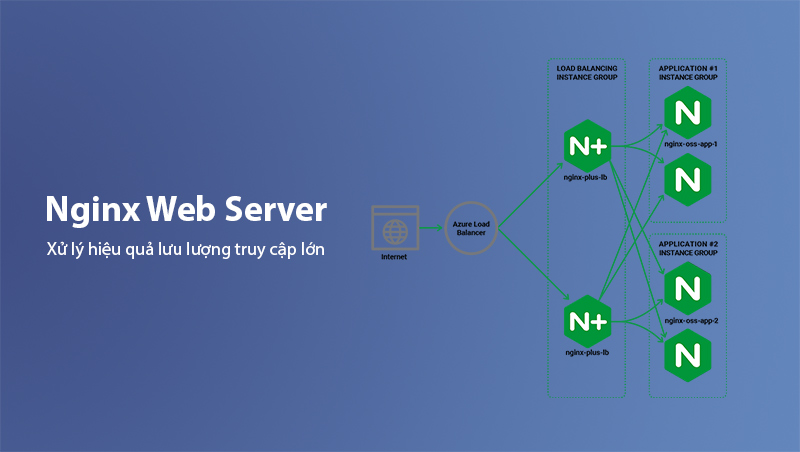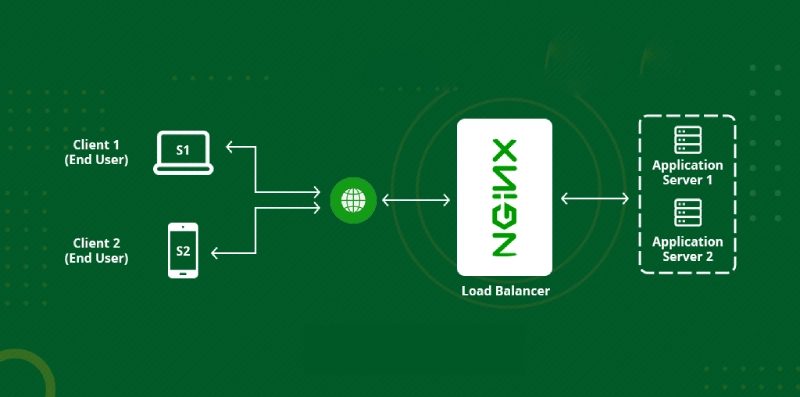Discover Nginx Web Server – Features, How It Works, and Applications
- Published on

- What is Nginx?
- History and Development of Nginx Web Server
- The Role of Nginx in the Technology Ecosystem
- Hosting and Content Delivery
- Load Balancing
- Integration with Modern Ecosystems
- Support for Modern Protocols
- How Nginx Works
- Event-Driven Processing Model
- Key Features in Nginx's Operating Principles
- Caching Support
- Advantages and Disadvantages of Nginx Web Server
- Advantages of Nginx Web Server
- Disadvantages of Nginx Web Server
- Summary
- Comparing Nginx with Other Web Servers
- Comparison: Nginx vs. Apache
- Comparison: Nginx vs. LiteSpeed
- Comparison: Nginx vs. Tomcat
- Practical Applications of Nginx Web Server
- Using Nginx in Enterprise Systems
- Deploying Nginx in Microservices and Containers
- Applications in CDN (Content Delivery Network) Systems
- Using Nginx in Large Organizations
- Detailed Nginx Installation Guide
- Installing Nginx on Linux (Ubuntu/Debian)
- Installing Nginx on Windows
- Installing Nginx on macOS
- Basic Configuration Steps After Installation
- Notes on Using Nginx Web Server
- Optimizing Nginx Performance
- Securing Nginx
- Log Management and Monitoring
- Integration with Other Technologies
- Regular Configuration Checks
- Conclusion
- Benefits of Using Nginx
- When to Choose Nginx?
- Limitations to Consider
What is Nginx?
Nginx, also known as Nginx Web Server, is an open-source web server designed to efficiently handle high traffic with excellent load capacity and superior performance. Nginx not only serves as a web server but also functions as a reverse proxy, load balancer, and supports HTTP caching. Thanks to its powerful and flexible features, Nginx has become one of the top choices for websites and applications worldwide, from personal projects to large enterprise systems.

History and Development of Nginx Web Server
Nginx was created in 2004 by Russian software engineer Igor Sysoev with the goal of solving the C10K problem – a well-known challenge in technology for handling 10,000 concurrent connections. At a time when traditional web servers like Apache struggled to handle a large number of connections, Igor Sysoev designed Nginx with an event-driven architecture, making it more resource-efficient.
Over more than a decade of development, Nginx has become one of the most popular web servers globally. In 2011, Nginx, Inc. was founded to provide commercial services for this open-source software. By 2019, Nginx was acquired by F5 Networks for $670 million, marking a significant milestone in expanding modern web services.
The Role of Nginx in the Technology Ecosystem
Nginx plays a vital role in operating modern websites and web applications. With its flexible processing capabilities, Nginx is applied in various technological domains:
Hosting and Content Delivery
Nginx excels at delivering static content such as HTML, CSS, JavaScript, and images at high speed. When acting as a reverse proxy, it forwards requests to backend servers and effectively reduces system load.
Learn more about how a Reverse Proxy works: What is a Reverse Proxy? Benefits and Applications in Networking.
Load Balancing
One of Nginx's key features is its Load Balancer, which distributes traffic across multiple backend servers, ensuring system stability and preventing overload.
Integration with Modern Ecosystems
Nginx seamlessly integrates with modern technologies like Docker, Kubernetes, and microservices architectures. This makes Nginx a popular choice for developers building distributed and high-load systems.
Interested in Kubernetes? Learn more: What is Kubernetes? Benefits and Applications in DevOps.
Support for Modern Protocols
In addition to supporting HTTP/1.1, Nginx also supports HTTP/2 and HTTP/3 (QUIC), enabling improved speed and security for modern websites.
Nginx is not just a web server but an indispensable part of deploying modern technology systems. With continuous development, Nginx increasingly asserts its crucial role in optimizing performance and enhancing user experience.
How Nginx Works
Nginx operates on an event-driven model, which differs entirely from traditional web servers that use process-driven or thread-driven models like Apache. This model helps Nginx optimize system resources and handle thousands of concurrent connections (Concurrency) efficiently.
Event-Driven Processing Model
The event-driven model of Nginx is based on non-blocking I/O and asynchronous processing. This means that Nginx does not create a new process or thread for each connection but uses a worker process to manage multiple connections simultaneously.
The process works as follows:
-
Receive a request from the client:
- When a browser or application sends an HTTP/HTTPS request, Nginx receives it through default ports (commonly port 80 or port 443).
-
Analyze and route the request:
- Based on the configuration in the
nginx.conffile, Nginx routes the request to the necessary resources or forwards it to backend servers (e.g., PHP, Python, Node.js applications).
- Based on the configuration in the
-
Process the request:
- For static content (such as HTML, CSS, JS), Nginx serves the content directly from memory or disk.
- For dynamic content, Nginx forwards the request to the backend using protocols like FastCGI, uWSGI, or gRPC, then returns the result to the client.
-
End the connection:
- After processing, Nginx closes the connection or keeps it in a persistent connection state to reduce latency for subsequent requests.
Key Features in Nginx's Operating Principles
Asynchronous Request Handling
Nginx handles requests asynchronously, meaning it does not wait for one request to finish before processing another. This allows Nginx to handle thousands of connections without overwhelming the system.
Example: If a client is downloading a large file, Nginx can still serve other clients without waiting for the file download to complete.
Worker Processes
Each worker process in Nginx can handle thousands of simultaneous connections thanks to mechanisms like epoll (on Linux) or kqueue (on FreeBSD). This optimizes CPU and memory usage.
Load Balancing Mechanism
Nginx includes built-in load balancing capabilities, allowing requests to be distributed across multiple backend servers. Commonly supported algorithms include:
- Round Robin: Sequentially distributes requests to backend servers.
- Least Connections: Routes requests to the server with the fewest active connections.
- IP Hash: Distributes based on the client's IP address to ensure session consistency.

Read more about What is Load Balancing? How It Works and Its Benefits.
Caching Support
Nginx has robust caching capabilities, allowing it to temporarily store static content or backend responses, reducing the number of direct requests to the server and improving overall performance.
Nginx Caching Process:
- Nginx receives a request from the client.
- It checks for the content in the cache.
- If the content is cached, it immediately returns the result.
- If not, Nginx forwards the request to the backend, caches the result, and sends it to the client.
Nginx's operational principles not only make it a high-performance web server but also a powerful tool for deploying high availability (HA) systems and scalable architectures.
Advantages and Disadvantages of Nginx Web Server
Choosing Nginx Web Server as the foundation for a website or web application depends on weighing its outstanding advantages against its limitations. Below is a detailed analysis of Nginx's strengths and weaknesses.
Advantages of Nginx Web Server
High Performance and Exceptional Concurrency Handling
Nginx is designed with an event-driven model and non-blocking I/O mechanism, allowing it to handle thousands of concurrent connections without consuming significant resources. This makes Nginx an ideal choice for websites or applications with heavy traffic.
Example: Major platforms like Netflix, Airbnb, and Instagram use Nginx to ensure superior performance while serving millions of users simultaneously.
Powerful Load Balancing Features
Nginx comes with built-in Load Balancing capabilities, enabling even traffic distribution across multiple backend servers. This helps reduce individual server loads and increases system stability.
- Popular load balancing algorithms:
- Round Robin: Evenly distributes requests among backend servers.
- Least Connections: Sends requests to the backend server with the fewest active connections.
- IP Hash: Ensures requests from the same client always go to the same backend.
Superior Static Content Delivery
Nginx is optimized for delivering static content such as HTML, CSS, JS, and images quickly, significantly reducing page load times.
Support for Modern Protocols
Nginx supports several advanced protocols, including:
- HTTP/2: Accelerates page loading and improves network efficiency.
- HTTP/3 (QUIC): Ensures faster data transmission with lower latency.
- gRPC: Suitable for microservices applications.
Easy Scalability and Integration
Nginx works effectively as a reverse proxy or API gateway, seamlessly integrating with modern technologies like:
- Docker and Kubernetes: Supports deployment in containerized environments.
- Microservices: Plays a role in managing traffic among small services.
Learn more: What is Microservices? Architecture and Benefits in Distributed Systems.
Low Resource Consumption
Thanks to its asynchronous design and smart process management, Nginx uses less CPU and RAM compared to traditional web servers like Apache, even when handling large numbers of connections.
Disadvantages of Nginx Web Server
Limited Customization Compared to Apache
Nginx does not support .htaccess files, making it less flexible for directory-specific configurations. Instead, all configurations must be made in the main nginx.conf file, requiring higher access permissions.
Steep Learning Curve
Although Nginx is very powerful, understanding and configuring it can be complex for beginners. This is especially true for advanced customizations or integrations with complex systems.
Limited Dynamic Content Handling
While Nginx excels at handling static content and caching, it requires backend servers (like PHP-FPM or uWSGI) for processing dynamic content. This can sometimes result in more complex configurations than Apache.
Frequent Knowledge Updates Required
Nginx is rapidly evolving, with new versions and features released frequently. This requires users to stay updated to take full advantage of its capabilities.
Summary
| Advantages | Disadvantages |
|---|---|
| Exceptional concurrency handling | Limited customization compared to Apache |
| Robust load balancing capabilities | Steep learning curve |
| Low resource consumption | Requires backend for dynamic content processing |
| Easily integrates with modern technologies | Requires advanced knowledge for optimization |
Nginx is not just a high-performance web server but also a powerful tool for deploying reverse proxy, load balancer, and other modern systems. However, before using it, you should carefully consider the benefits Nginx brings and the potential limitations.
Comparing Nginx with Other Web Servers
In the world of web servers, Nginx is not the only option. Web servers like Apache, LiteSpeed, and Tomcat are also strong competitors. Understanding the differences between Nginx and these platforms will help you make the right decision based on your needs.
Comparison: Nginx vs. Apache
Apache and Nginx are the two most popular web servers today, each with distinct advantages and disadvantages. Below is a comparison table of Nginx and Apache:
| Criteria | Nginx | Apache |
|---|---|---|
| Architecture | Event-driven | Process-driven |
| Performance | Handles thousands of simultaneous connections exceptionally well | Lower performance in high-traffic environments |
| Load Balancing | Built-in and highly efficient | Requires additional modules |
| Dynamic Content Handling | Requires backend like PHP-FPM | Handles directly with mod_php |
| Customization | More limited due to lack of .htaccess support | Highly flexible with .htaccess files |
Learn more: What is Apache? Features and Role of Apache Web Server.
Comparison: Nginx vs. LiteSpeed
LiteSpeed is a highly optimized commercial web server, particularly effective in handling PHP applications. Compared to Nginx, LiteSpeed has the following strengths and weaknesses:
Strengths of LiteSpeed:
- Integrates LSAPI technology, providing higher performance for PHP.
- Supports direct .htaccess management without modifying the main configuration file.
- Comes with built-in security features like DDoS Protection.
Weaknesses of LiteSpeed:
- LiteSpeed is not open-source, increasing deployment costs compared to Nginx.
Comparison: Nginx vs. Tomcat
Tomcat is a specialized web server for Java EE applications such as Servlet and JSP. While Tomcat is not designed for static content delivery like Nginx, it is a powerful tool for running Java applications.
| Criteria | Nginx | Tomcat |
|---|---|---|
| Primary Language | PHP, Python, Node.js, any language | Java |
| Main Purpose | Static and dynamic content delivery | Running Java-based web applications |
| Static Content Performance | High | Low |
Nginx excels in handling static content, distributing traffic, and supporting modern protocols. However, depending on specific requirements, you can choose or combine it with other web servers to optimize your system.
Practical Applications of Nginx Web Server
Nginx is not just a typical web server but also plays a significant role in many modern technology fields. With outstanding performance and robust integration capabilities, Nginx has become the top choice for large enterprises and organizations. Below are real-world applications of Nginx in various technology systems.
Using Nginx in Enterprise Systems
As a Reverse Proxy
Nginx is widely used as a reverse proxy, forwarding client requests to backend servers (e.g., PHP, Python, or Node.js applications). This not only reduces backend load but also enhances security by hiding backend server details.
Example: A large e-commerce platform like Amazon may use Nginx as a reverse proxy to protect its backend and improve response speed for customers.
Load Balancing
Nginx acts as a load balancer, evenly distributing traffic to backend servers. This ensures system stability, even during sudden traffic surges.
Example: Large websites like Netflix use Nginx to balance millions of access requests daily.
Content Caching
Nginx is applied as an HTTP cache server, temporarily storing static content or backend responses. This reduces the number of requests to the backend and accelerates page loading.
Deploying Nginx in Microservices and Containers
Nginx easily integrates with microservices architectures and container tools like Docker and Kubernetes. It can be configured as an API gateway to manage traffic between small services, ensuring performance and security.
Applications in CDN (Content Delivery Network) Systems
Nginx is used in CDN systems to deliver content to end-users from the nearest servers. This minimizes latency and enhances user experience.
Example: Cloudflare, one of the largest CDN providers, uses Nginx as a foundation to accelerate content delivery.
Using Nginx in Large Organizations
- Technology Platforms: Companies like Google, Facebook, and LinkedIn use Nginx to handle massive daily traffic.
- Education: Nginx is deployed in universities and online education systems to deliver educational content quickly and efficiently.
- Government: Government organizations choose Nginx for its security and ability to handle large-scale data.
Nginx is not limited to small websites but is also an ideal solution for large systems, from enterprises to government organizations. With flexibility and high performance, Nginx continues to assert itself as one of the most powerful web servers in the world.
Detailed Nginx Installation Guide
Installing Nginx Web Server is simple and can be done on various operating systems. Below is a detailed guide to setting up Nginx on Linux, Windows, and macOS, along with basic configuration steps.
Installing Nginx on Linux (Ubuntu/Debian)
Nginx is included in the software repositories of most Linux distributions. You can install it with just a few commands:
Installation Steps:
-
Update package lists:
sudo apt update -
Install Nginx:
sudo apt install nginx -
Start Nginx:
sudo systemctl start nginx -
Ensure Nginx starts at boot:
sudo systemctl enable nginx -
Check Nginx status:
sudo systemctl status nginx -
Browser test: Access
http://<server-ip>in your browser. If you see the Nginx default page, the installation was successful.
Note: For further customization, you can edit the main configuration file at
/etc/nginx/nginx.conf.
Installing Nginx on Windows
Although less popular than on other platforms, Nginx can still be installed and run on Windows.
Installation Steps:
-
Download Nginx: Visit the official Nginx download page and select the Windows version.
-
Extract and Configure:
- Extract the downloaded file to a directory, e.g.,
C:\nginx. - In the directory, edit the
nginx.conffile if necessary.
- Extract the downloaded file to a directory, e.g.,
-
Start Nginx:
- Open Command Prompt or PowerShell.
- Run the command:
cd C:\nginx start nginx
-
Access Nginx: Navigate to
http://localhostto check.
Installing Nginx on macOS
You can install Nginx on macOS using Homebrew.
Installation Steps:
-
Install Homebrew (if not already installed):
/bin/bash -c "$(curl -fsSL https://raw.githubusercontent.com/Homebrew/install/HEAD/install.sh)" -
Install Nginx:
brew install nginx -
Start Nginx:
sudo nginx -
Check Operation: Open
http://localhostin your browser.
Basic Configuration Steps After Installation
Creating Virtual Hosts
Virtual Hosts allow you to configure multiple websites on the same server.
-
Create a new configuration file:
sudo nano /etc/nginx/sites-available/example.com -
Add the configuration content:
server { listen 80; server_name example.com www.example.com; root /var/www/example.com; index index.html; } -
Enable the Virtual Host:
sudo ln -s /etc/nginx/sites-available/example.com /etc/nginx/sites-enabled/ sudo systemctl reload nginx
Enabling HTTPS with SSL
-
Install Let's Encrypt (Certbot):
sudo apt install certbot python3-certbot-nginx -
Request an SSL certificate:
sudo certbot --nginx -d example.com -d www.example.com -
Set up automatic renewal:
sudo certbot renew --dry-run
Installing Nginx is not only straightforward but also provides flexibility to configure according to your needs. Depending on your operating system and application, you can leverage Nginx as a powerful web server, a reverse proxy, or an efficient load balancer.
Notes on Using Nginx Web Server
While Nginx Web Server is a powerful and efficient tool, to maximize its potential, it’s essential to consider certain aspects related to performance, security, and scalability.
Optimizing Nginx Performance
Tuning worker_processes and worker_connections
- Parameters like
worker_processesandworker_connectionsin thenginx.conffile should be configured according to system resources:worker_processes auto; events { worker_connections 1024; }- worker_processes: Should be set to
autoto utilize all CPU cores. - worker_connections: Defines the number of simultaneous connections each worker process can handle.
- worker_processes: Should be set to
Enable Gzip Compression
- Compressing data reduces the amount of data transmitted, improving page load speed:
gzip on; gzip_types text/plain text/css application/json application/javascript text/xml application/xml application/xml+rss text/javascript; gzip_min_length 256;
Use Caching
- Nginx supports caching to temporarily store content and reduce backend load:
proxy_cache_path /var/cache/nginx levels=1:2 keys_zone=my_cache:10m max_size=10g inactive=60m use_temp_path=off;
Securing Nginx
Keep Nginx Updated
- Regularly check and update Nginx to ensure that security vulnerabilities are patched:
sudo apt update sudo apt upgrade nginx
Hide Sensitive Information
- By default, Nginx displays version information, which can be exploited. Disable it by editing the
nginx.conffile:server_tokens off;
Configure HTTPS
- Use SSL/TLS to encrypt data between the client and the server:
- Install SSL certificates from Let's Encrypt or a trusted provider.
- Redirect all HTTP traffic to HTTPS:
server { listen 80; server_name example.com; return 301 https://$host$request_uri; }
Mitigate Brute Force and DDoS Attacks
-
Use modules like ngx_http_limit_req_module to limit the number of requests from a single IP:
limit_req_zone $binary_remote_addr zone=one:10m rate=5r/s; server { location / { limit_req zone=one burst=10 nodelay; } }
Log Management and Monitoring
Monitor Logs
- Nginx access and error logs are critical for tracking and diagnosing issues:
- Access log file:
/var/log/nginx/access.log - Error log file:
/var/log/nginx/error.log
- Access log file:
Integrate Monitoring Tools
- Use tools like Prometheus, Grafana, or Elastic Stack (ELK) to monitor the performance and health of Nginx.
Integration with Other Technologies
Docker and Kubernetes
- When using Nginx in a containerized environment, leverage the official Nginx images from Docker Hub:
docker run -d -p 80:80 nginx
API Gateway
- In microservices architectures, Nginx is often used as an API Gateway to manage traffic and ensure security.
Regular Configuration Checks
-
Use the configuration test command to ensure no errors when changes are made:
sudo nginx -t -
Restart Nginx after validating the configuration:
sudo systemctl reload nginx
These best practices will not only help you optimize Nginx's performance but also ensure the system's security and stability in real-world use cases.
Conclusion
Nginx Web Server has established itself as one of the most powerful and efficient tools for deploying modern web systems. With its ability to handle high traffic, low resource consumption, and advanced features like Load Balancing, Reverse Proxy, and Caching, Nginx has become a top choice for enterprises and organizations worldwide.
Benefits of Using Nginx
- Superior Performance: Nginx can handle thousands of simultaneous connections without degrading performance.
- Scalability: Easily integrates with modern technologies like Docker, Kubernetes, and Microservices.
- Versatility: Functions efficiently as a web server, reverse proxy, load balancer, and API gateway.
- Extensive Community Support: As open-source software with a large community, users can easily find documentation, support, and feature updates.
When to Choose Nginx?
- High-Traffic Websites or Applications: With its ability to handle thousands of simultaneous connections, Nginx is ideal for e-commerce sites, online applications, or streaming systems.
- Load Balancing Requirements: Nginx's built-in Load Balancing feature ensures effective traffic distribution.
- High Security Demands: Nginx supports HTTPS and integrates advanced security tools.
Example: Companies like Netflix, Dropbox, and Airbnb have implemented Nginx to ensure performance and security for their systems.
Limitations to Consider
Despite its strengths, Nginx has some limitations:
- Steeper learning curve, especially for beginners.
- Does not support
.htaccessfiles like Apache, making directory-specific configurations more challenging.
Nginx is not only a high-performance web server but also a comprehensive tool for building and operating complex web systems. Choosing Nginx as a foundation depends on the specific needs of your project, from traffic scale to integration capabilities.
If you’re looking for an efficient web server solution, Nginx is undoubtedly worth considering.
Latest Posts

Lesson 26. How to Use break, continue, and return in Java | Learn Java Basics
A guide on how to use break, continue, and return statements in Java to control loops and program execution flow effectively.

Lesson 25. The do-while Loop in Java | Learn Basic Java
A detailed guide on the do-while loop in Java, including syntax, usage, examples, and comparison with the while loop.

Lesson 24. How to Convert Decimal to Binary in Java | Learn Basic Java
A guide on how to convert numbers from the decimal system to the binary system in Java using different methods, with illustrative examples.

Lesson 23. How to Use the While Loop in Java | Learn Java Basics
Learn how to use the while loop in Java with syntax, real-world examples, and practical applications in Java programming.
Related Posts

What is .htaccess? Guide to Editing and Configuring .htaccess
Learn about the .htaccess file, its functions, and how to edit and configure .htaccess to optimize security, SEO, and website performance.

What is DNS? The Mechanism of Domain Name Resolution System
Learn about DNS, the mechanism of the domain name resolution system, and the important role of DNS in maintaining website operations.

What is a Dedicated Server? A Guide to Choosing the Right Dedicated Server
Learn about Dedicated Servers, the benefits of using a dedicated server, and how to choose the right one for your needs.

Difference Between Web Server and Application Server
Learn the difference between Web Server and Application Server – two essential servers in web technology systems. Explore their structure, functions, how they work, and when to use each type of server.

